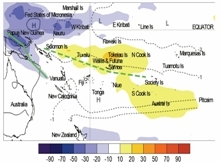Climate developments in July 2009.

Outgoing Long-wave Radiation (OLR) anomalies, in Wm2 are represented by hatched areas. High radiation levels (yellow) are typically associated with clearer skies and lower rainfall, while cloudy conditions lower the OLR (blue) and typically result in higher rainfall. The July 2009 position of the South Pacific Convergence Zone (SPCZ) was displaced southwest of its normal position, less extensive, and and weakly coherent compared to previous months. The average position of the SPCZ is identified by the dashed green line, which is based on mean January rainfall for the South Pacific. Mean sea level (MSL) pressure anomalies (in hPa) are shown as solid and dashed black lines.
The South Pacific Convergence Zone (SPCZ) was displaced slightly southwest of its normal position last month, and contracted toward the Equator. Convection intensified near the Federated States of Micronesia and northern Papua New Guinea and enhanced rainfall was also observed over Nauru and Western Kiribati during July. Suppressed convection existed southeast of Western Kiribati last month and near Tokelau. The regional circulation in July was characterised by more frequent low pressure over the Equator near Eastern Kiribati, south of the Austral Islands, and east of New Zealand. This pattern resulted in more frequent easterly anomalies in the northern Tuamotu Archipelago region and the Marquesas, with westerlies being more frequent in the Austral Islands.
Most stations in Papua New Guinea and New Caledonia received well above normal rainfall in July. High rainfall was also recorded in the Solomon Islands, the southern half of Vanuatu, most of Samoa, and in Western Kiribati. For Western Kiribati this is the second month in a row with considerable rainfall, and a break from drought conditions that persisted in the southern part of that island group during previous months. In addition, there were only three days in July without rain at Tarawa. In contrast to last month in Fiji, only three sites (Nadi, Lakita, and Rarawai) reported for the ICU had well above average rainfall, while 19 other sites received above normal rainfall for the month.
Drier than normal conditions occurred over much of the central and eastern regions of the South Pacific during July. Low rainfall totals in Tonga occurred at Niuafo’ou and Mata’aho, which received 23% and 15% of normal rainfall, respectively. There were also dry conditions in northern Vanuatu (Sola and Pekoa), and in the Tuamotu Archipelago and parts of the Society Islands, with less than 50% of normal rainfall recorded in Gambier. Near normal rainfall was recorded for Bora Bora.
Warmer than normal conditions occurred as a whole across French Polynesia during July, with +0.5°C to +1.4°C above normal temperatures recorded. A new monthly mean temperature was also recorded for July at Faa’a, and a maximum daily temperature of 26.9°C was recorded at Rikitea. Across the Southwest Pacific in Australia, air temperatures were 1–2 °C above average in northern regions of the continent.
| Island Group | Location | Rainfall (mm) | % of average | Comments |
|---|---|---|---|---|
| Solomon Islands | Munda | 591 | 184 | Highest monthly total in the region |
| New Caledonia | Moue | 220 | 259 | Very high |
| Papua New Guinea | Kavieng | 564 | 239 | Very high |
| Takaroa | Tuamotu | 34 | 41 | Very low |
| Australia | Townsville | 0.2 | 18 | Very low |
